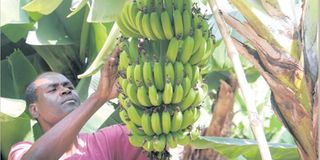My money grows on bananas

Michael Agalo tends to his bananas that he grows at a farm in Kisumu. PHOTO | JACOB OWITI
What you need to know:
- Each farmer was given 25 suckers in form of a loan. They were to plant the crop and after they produced suckers, they would harvest and give to other farmers five suckers each.
- According to Dr Lusike Wasilwa of Kenya Agriculture Research Institute, the Uganda Green and Williams banana varieties have a wide adaptability.
The huge banana plants on his farm in Kisumu County are like a magnet, as they attract people who come to ask if they can buy them.
Michael Agalo, the owner of the farm, says he receives several queries about the bananas that have turned him into a point of reference in his village when it comes to good farming practices.
“The bananas are tissue cultured varieties,” he says. “In tissue culture, there are three varieties. I plant two — Uganda Green and Williams variety — which do very well here.”
The varieties are pest and disease resistant and they give higher yields. Agalo went into banana farming after Africa Now, an NGO, visited the region and encouraged them to venture into agribusiness.
“They brought together people who were interested in farming and asked us to choose what we wanted to plant. Other villagers and I chose bananas because we knew they had a ready market.”
Each farmer was given 25 suckers in form of a loan. They were to plant the crop and after they produced suckers, they would harvest and give to other farmers five suckers each.
To plant bananas, Agalo explains, one should first dig a hole of about 1m wide by 1m deep. One then separates the top soil from sub soil.
“You then mix the top soil and compost manure in the same ratio and then put the mixture into the hole.” The mixture is left for one month for good mixing before planting. “When you plant the sucker immediately into the soil, the compost manure can burn it because it normally produces a lot of heat, which is dangerous to the crop.” After about a month, one plants the suckers. “Mulching is necessary. This can be done by use of dry grass or leaves to prevent evaporation. Mulching also adds moisture into the soil.”
After every six months, the plant should be top-dressed with urea or Calcium ammonium nitrate fertiliser.
“The plant will produce many suckers, which should be harvested, but the mother plant should be left to produce more,” he explains. To get good yields and to avoid many suckers in a single hole, three suckers should be left in each hole.
He supplies his bananas to hotels in Kisumu, and at times sells to small-scale buyers on his farm. He also sells them in markets in Kisumu.
“I have a ready market at Kibuye on Sundays,” says Agalo, who makes at least Sh20,000 per month from the crop.
The bananas sell for between Sh500 to Sh1,000, depending on size.
“If you want to keep customers happy, you must produce the best by spending on new techniques and varieties,” says Agalo, who also grows traditional vegetables, tomatoes and beans. The three crops earn him an additional Sh50,000 a month. He depends on rain, thus during dry seasons, he parts with huge sums of money to water his crops.
According to Dr Lusike Wasilwa of Kenya Agriculture Research Institute, the Uganda Green and Williams banana varieties have a wide adaptability.
She adds that Uganda Green is good for cooking, is sweet and has a nice smell. Williams has a good ripening characteristic, has good taste, is large and mild, which is good for commercial purposes.
“Bananas are very good sources of potassium, which can help relax the pounding blood vessels. They help to cure or prevent hangovers. The main causes of hangovers are dehydration and depletion of potassium. If you want to avoid a hangover, drink water and eat a banana.”




